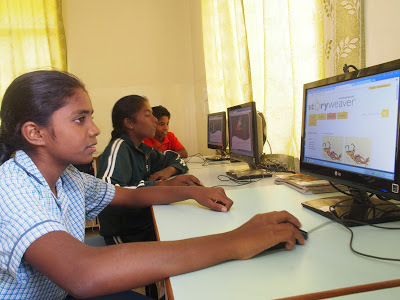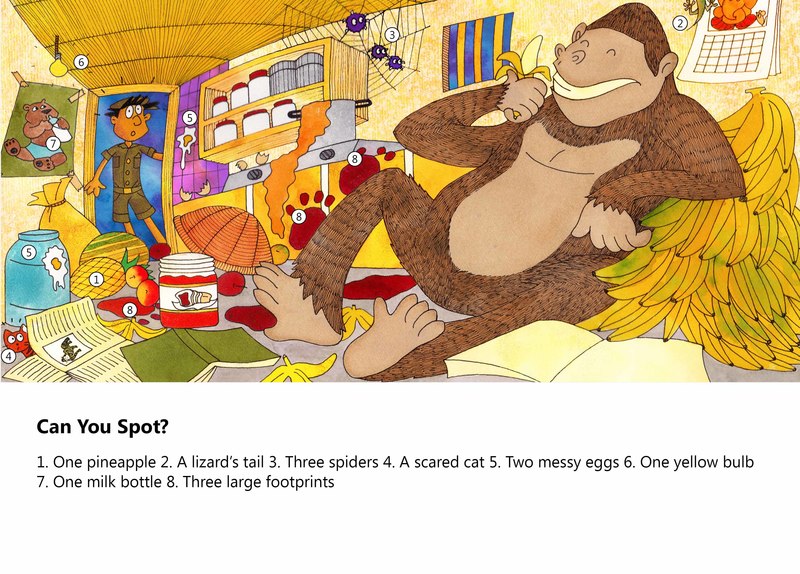Storyweaver poised for its next phase of growth : More stories. More access. More children reading!
Posted by Amna Singh on April 06, 2017We, at Pratham Books, have had an amazing journey over the past 18 months since the launch of StoryWeaver, when we created a gateway to thousands of open access stories in mother tongue languages for children. The interactive nature of the platform has allowed users not just to read the stories but also translate, version, and download and print the stories for use.
We are now poised to take the next leap, thanks to Google.org, whose grant makes it possible for us to scale up StoryWeaver to provide more stories in more languages to children all over the world. Access to learning and information is part of Google’s core values and the organization has announced a $8.4M commitment to help scale four groundbreaking education nonprofits working in India to make a quality education a reality.
StoryWeaver has enabled access to a staggering 3000 stories in 67 languages in the past 18 months. These stories ae being reimagined and translated for the enjoyment of children of all ages, and their digital format allows them to reach the remotest of areas, and the least-served children. We have been overwhelmed by the response of our wonderful community that has contributed their time and talent to create, translate and version the stories and take them to more children. Imagine our delight when we discovered that it also spoke for unrepresented languages that are the mother tongue languages of some of the most disadvantaged children. From minority languages like Tibetan and Konkani, to tribal languages like Kora and Santali and endangered languages like Kurdish, StoryWeaver is a rich source of children’s storybooks, which, as we know, are an essential pathway to literacy.
Suchana, based in Birbhum, West Bengal, has been working to improve the lives of the large Adivasi tribal community in that region by implementing education and health programmes. One of the challenges faced by them was that while children spoke Kora and Santali at home, learning materials were only available in Bangla, which is the dominant language of that region. Even though, the indigenous Adivasi languages of Kora and Santali are the first languages of the people of the region, there was a dearth of original learning material. This changed dramatically when Suchana began to use the StoryWeaver platform for translation. In a year and a half, almost 70 new stories in Kora and Santali have been translated and published on the platform. Even as you read this, 10,000 copies of books in these languages are being printed for use in their school programmes.
The grant from Google.org will provide a big boost to our work with StoryWeaver, propelling it to the next level of reach and influence. It will encourage the generation of thousands of new, engaging stories to be distributed even more widely, and read and enjoyed by hundreds of thousands of children across the globe.
With this, we will take a big step forward in fulfilling our mission of ‘a book in every child’s hand’.
Be the first to comment.
Hello Hyderabad! Pratham Books is conducting a StoryWeaver workshop!
Posted by Remya Padmadas on February 13, 2017Pratham Books is conducting a special workshop on StoryWeaver - an open source, digital repository of multilingual children’s stories.
The workshop will be held in Hyderabad on 22nd and 23rd February,2016. (Wednesday-Thursday) (You can attend it any one day).
The workshop would cover the following
1. A detailed Demo of StoryWeaver – how to navigate and use the platform
2. Examples of how educators are using StoryWeaver effectively in their classrooms
3. Dedicated work time for participants to try their hands on StoryWeaver
4. An opportunity to meet people from similar fields and make interesting conversations
(Read about previous StoryWeaver workshops here and here.)
So if you are:
- a librarian or resource lead looking to curate stories
- an educator in search of interesting ways to introduce concepts to your students
- a storyteller or a reading champion
- someone passionate about children's storybooks in Indian languages ...

Please note that the seats are limited and only confirmed participants will get a separate email confirming their participation, date of attendance and other logistical details.The workshop will be held at Madinaguda, Chandanagar- Hyderabad between 11 a.m to 4 p.m. There is no charge to attend the workshop.
We look forward to seeing you! If there are any queries, please email us at [email protected]
Be the first to comment.Spotathon: An Illustration Campaign to Create a Free Spotting Book
Posted by Remya Padmadas on November 14, 2016This campaign is now closed
Children LOVE ‘spotting challenges’. Ask them to spot anything from a busy image and you can be sure they won’t quit. 3 crabs on a beach, 4 tyres in a workshop, 11 spoons in a kitchen... anything! Unfortunately, it’s hard to come by memorable spotting books which are affordable. So...
This Children’s Day (November 14), StoryWeaver is eager to create a fun spotting book for children and make it available for free. We think this will be special if it’s a collection of illustrations from artists around the world. And this, illustrators, is where we need your support. Just 1 illustration from you can make all the difference!
The best entries from Spotathon will become part of a grand spotting book published by StoryWeaver, filled with illustrations from different artists. However, each entry that is submitted as part of Spotathon will be available on StoryWeaver as an individual activity book as well.
Here’s how you can participate in Spotathon!
-
Draw something which has enough details so that a child can spot up to 15 objects in it. Think of a setting which can accommodate these details. A beach, rainforest, kitchen, classroom, market... the possibilities are endless! The objects to spot are up to you.
-
Before you start, imagine the child you’re setting the challenge for. Our readers are primarily children who haven’t had much access to books. We have 2 different categories which are linked to age and levels of difficulty. Remember, these are only guidelines.
a. 3-6 years (Level of Difficulty: Easy) – She has only recently started reading books. She’d enjoy spotting up to 8 objects. While she’s open to all kinds of settings, do remember that her vocabulary is limited. But her imagination definitely isn’t! As an example, here is an illustration by Soumya Menon of what would be ideal for her.

b. 7-10 years (Level of Difficulty: Medium) – As she’s expanding her vocabulary, she will be more comfortable with prediction and open to unfamiliar settings. She’d be able to spot up to 15 things. Even the way in which the objects are hidden can be more complex here. As an example, here is an illustration by Bindia Thapar of what would be ideal for her.

-
As the spotting exercise also requires an answer key for reference, you will need to prepare it using the same drawing. All you have do it number the images accordingly. Here’s an example.

GUIDELINES FOR SUBMISSION
Timelines
Spotathon begins on October 25 and ends on November 21.
Submission
-
You will have to submit two illustrations: Main Illustration and Answer Key (examples above).
-
You can submit your entry in any language that is available on StoryWeaver.
-
You can submit more than one entry.
-
Watch a short Video Tutorial on how to submit your entry on StoryWeaver.
Format
-
Size of illustration (Main illustration & Answer Key): 11.17 inches (width) x 5.35 inches (height). This is the recommended size as it fits neatly into one of the templates on StoryWeaver.
-
The illustrations should be high-res (150-300 dpi).
-
Format: JPEG
-
File size for each illustration: Between 2 to 4 MB; above 4 MB will slow down the upload process
Copyright and other guidelines:
-
To participate in Spotathon, you must be over the age of 16.
-
The illustrations you submit must be your original work.
-
By submitting your work, you are agreeing to a CC-BY 4.0 license being applied to it. To know more about this license, click here.
You can register for the campaign over here so that we know you're participating and can reach out for any updates. If you have any queries, feel free to drop us an email at [email protected]!
Be the first to comment.

